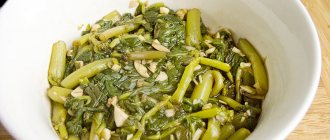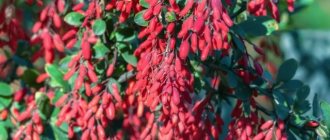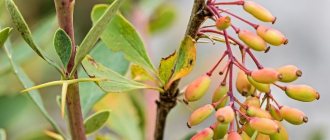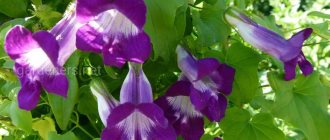Hops are a climbing flowering plant belonging to the hemp family. Widely used as a medicine, for the production of alcoholic beverages and the food industry.
Author of the article
Eduard Dmitriev
Florist and lover of indoor and garden plants.
It has a high decorative value and is used for vertical landscaping of fences, arches, room walls, and carved trellises. The aesthetic use of hops is limited only by the designer’s imagination.
Description
Common hop, also known as climbing hop, is a vine plant whose stem curls clockwise and can reach a length of more than 7 meters. It should be noted that this plant is covered with toxic thorns.
The plant is male and female. It is on female specimens that valuable cones appear.
The shape of the leaves depends on the age of the hop. Thus, the young leaves growing at the top of the shoots are whole. Three-fingered leaves can be seen in the middle part of the branches. Closer to the base are five-fingered leaves.
Another distinctive feature of hop leaves is that on the front side they are painted in a darker color and have a hard surface. The underside is much lighter, and the texture of the leaves is smooth, with small spines located along the veins.
If there is support, the hop begins to grow vertically upward, otherwise it grows in the horizontal direction.
The plant easily adapts to new growing conditions, so the vine can be found not only in the temperate climate zone of Eurasia, but also on other continents.
Since ancient times, hops have been grown as a material for obtaining fermentation products and making beer and bread. Young hop leaves were eaten as greens rich in nutrients. Not only leaves, but also hop shoots were used: they were used to make fiber for coarse textiles, ropes and even paper.
A decoction made from the cones acted as a natural dye for fabrics.
Even in ancient libraries, hops found application - the cones were used to reduce indoor air humidity and prevent the development of mold and fungal diseases.
Nowadays, the pleasant resinous taste has made the climbing plant a popular dish among restaurateurs.
In many countries, the vine is considered a symbol of good luck, prosperity and well-being. He is depicted on coats of arms and coins.
Blank
They begin to prepare raw materials in August. It is necessary to collect cones and leaves of the plant in dry weather. It is necessary to strictly observe safety precautions when collecting raw materials, since hops produce toxic substances.
Cones are taken only in bright yellow-green color. The raw materials are dried in a dark, ventilated place for ten days. It is then placed in paper bags. The raw material is stored for no more than three years, after which it is not suitable for use, as it loses all its beneficial qualities.
Useful properties and contraindications
The importance of hops in the medical field cannot be underestimated.
The beneficial properties of vines have been known since ancient times. It was used as a blood purifier and also as a sleeping pill. Flour from dried cones was added to ointments that were used to treat radiculitis, rheumatism and to speed up the healing of wounds.
Today, preparations containing hops are also used to treat hormonal imbalances. They promote the active production of female hormones.
The substances that make up the plant have anti-inflammatory properties and help get rid of allergies.
The presence of hops in medicines helps with diseases of the skin and nasal mucosa.
Treatment with hops is effectively used for dermatitis (allergic and also occupational), degenerative processes that manifest themselves in the skin and mucous membranes.
Cones can be used for diseases of the bladder and kidneys.
Hops can help with stress, sleep disorders, vegetative-vascular dystonia and during menopause in women.
There are usually no side effects when using hops. However, experts do not recommend using drugs containing this component in large quantities and urge you to consult a specialist before using any medicines.
Use in cosmetology
Hops are used to produce skin and hair care products.
Hop-based shampoos are great for those with fine and oily hair.
Hair products containing hops will help get rid of seborrhea and problems associated with hair loss.
If we talk about skin care products, the presence of hops in their composition improves skin tone, improves blood flow and even helps in the fight against rosacea.
In perfumery, flowers and cones of vines are used as a fragrance in the manufacture of perfumes.
Application in brewing
Hops are an indispensable component for making beer.
This plant:
- gives beer a pleasant bitterness;
- improves the taste and aroma of the drink;
- improves foam quality;
- acts as a natural preservative.
Female hop cones are used in brewing. On the inside of the scales of the cone there are glands that secrete a variety of chemicals necessary for making beer. In dried form, all chemicals are a yellowish powder - lupulin.
For brewers, the main components of lipulin are:
- alpha acids;
- beta acids;
- essential oils.
The percentage content of three groups of these chemical elements allows us to divide hops into bittering, aromatic and dual-purpose.
Types and varieties
The variety of common hops is determined by the percentage of aromatic substances in the cones. Thus, all varieties of common hops are divided into:
- red - this includes the most popular varieties with a short growing season. The vine is painted red. Cones are actively used in brewing;
- semi-red – used to give beer wort characteristic notes (citrus, woody);
- green - have a long growing season. The buds have too strong an aroma, which is why many brewers consider them unsuitable for making beer. The most popular varieties are “Württenberg”, “Gersbruck”, “Buvrinnes”.
The following varieties are particularly widespread in our country:
- Brewer – semi-red variety. It is frost and moisture resistant. It is used not only for brewing, but also for landscaping;
- Triumph is resistant even to adverse weather conditions and tolerates severe frosts well. It has a cylindrical vine with round, medium-sized cones;
- Oscar is a mid-season variety that can withstand both drought and frost. This variety has very good fruiting;
- Vidibor is a semi-red variety with aromatic cylindrical cones. Gives a good harvest, is resistant to diseases and pests.
Common hops also have decorative varieties, such as:
- Aureus is a small vine with green leaves with a golden tint;
- Cascade is an ornamental variety with beautiful large, loose, rounded cones;
- Prima Donna is a small herbaceous plant with a long stem and large cylindrical cones that densely cover the plant.
Benefit
- The inflorescences are used in the food industry for brewing beer and are used in home cooking.
- The plant has recognized medicinal qualities, which are used in the treatment of various ailments.
- The plant is widely used in cosmetology.
- Japanese grass, like common hops, is used in landscape design to decorate elements in summer cottages and garden plots; they decorate the walls of mansions and decorate fences.
How to care
To ensure that the vine does not suffer from diseases and insect infestations, and also does not grow too actively, it is necessary to follow a few simple rules.
Soil selection
The best option is neutral or slightly acidic soils, such as fertile loam. Maximum permissible acidity level: pH 5.5.
Location and lighting
For planting hops, a place in partial shade or a sunny area is suitable, provided that the vine is not exposed to direct rays of the sun.
Temperature, humidity, watering
Active growth of the vine occurs when the ambient temperature is +20...+22 degrees. The growing season begins at +10 degrees Celsius.
Hops are a moisture-loving plant, which, however, does not tolerate overwatering. As a rule, watering one adult plant will require 10-20 liters of water at a time.
Fertilizers and fertilizers
A young plant (the first 2-3 years of life) is regularly fed with liquid mullein or purchased organomineral fertilizers.
Transfer
Transplanting hops to a new place is not an easy task, because the root system of the vine grows very actively. You can replant young plants with a small root system. Or prepare new planting material and then grow an adult vine.
For transplantation, prepare holes 50 cm deep. They are half filled with manure, covered with earth on top and left until spring. The holes should be located at a distance of about 1 meter from each other, and there should be a distance of about 3 meters between the rows. During transplantation, seedlings are planted in prepared holes, covered with soil, compacted and watered.
Trimming
Pruning must be done every fall before frost sets in. In this case, the above-ground part of the vine is cut off.
Harvesting
Hop cones are used for various purposes. Some people eat them raw or add them to a dish; someone stuffs pillows with them; and some use them for self-medication. But it doesn't matter why you collect them, but what matters is how you do it.
When to collect hop cones
Cones should be collected when they have reached their maturity. This can be determined by several factors:
- they have lost their airiness;
- scales fit tightly to the base of the fruit;
- when pressed, the lump becomes elastic, and the pressure mark quickly disappears;
- they become lighter in color: often golden-green or green-yellow;
- they become sticky;
- have a more noticeable odor.
By the way, as soon as you notice all the signs, harvest immediately. You cannot leave the cones on the plant too long, otherwise they will turn brown. Because of this, their quality will deteriorate.
Of course, it is not enough just to know that the cone is already ripe. It is important to collect raw materials correctly.
How to collect hop cones
First, pick off the largest cones with small petioles. Moreover, each one must be picked separately. When the largest ones are gone, collect the rest.
After collecting, place the cones in a container so that they lie freely. Do not create any dense deposits.
To grow climbing hops, you need to choose the right place for planting, water regularly, trim off excess shoots and irrigate the plant with products that will protect it from diseases and pests.
Reproduction methods
Propagating hops is a very simple task.
Vegetative method of propagation
Most often used. To do this, parts of the rhizomes with buds are carefully separated from the mother plant, while the latter is not dug out of the ground. In the spring, after the first shoots appear from the ground, small pieces of rhizomes are isolated using a shovel and transplanted to a prepared place.
Cuttings
To prepare rhizome cuttings, you need to choose the right time. This is done before the juices begin to flow.
For propagation, the rhizome is dug up, divided into fragments, which are planted in a new area.
Reproduction using layering
For this method, in the month of July, the vine is pinned to the ground and sprinkled. The cuttings should remain in this position until spring. During this time, the cuttings will form their own root system and can be dug up and replanted.
Seeds
This propagation method is used if there is a need to plant large hop plantations or if it is necessary to grow an unusual variety. For seed propagation, soil is poured into the boxes, which is then well moistened. After this, the seeds are planted. After the shoots appear, they are transferred to the ground and cared for in the same way as adult specimens.
How to remove from the site
The active growth of hops sometimes becomes the reason that gardeners are looking for a way to remove this plant from the site.
There are several most effective methods for solving the problem.
Herbicide use
To get rid of hops, you can use the preparations “Roundup”, “Tornado”, “Hurricane”.
Herbicides can be applied as follows:
- spraying;
- introducing the drug into the root system with a syringe;
- application at the root;
- applying with a brush to the trunk.
Application of fertilizers
A little bit of good stuff. Thus, excessive use of fertilizer can turn into poison for hops. A large amount of ammonium nitrate poured under the root will help get rid of the vine.
Digging
This must be taken care of even before flowering begins. All hop roots must be removed from the soil.
Traditional methods
Folk methods of dealing with actively growing vines include the use of soda and vinegar.
To remove a plant from the site, water it with a 9% vinegar solution diluted with water in a 1:1 ratio.
Watering with a soda solution (1 liter of water and 500 grams of soda) will also destroy the plant.
Soil requirements
It is believed that with proper cultivation and proper fertilization, almost any soil can be used for growing hops. However, both quantitatively and qualitatively the yield will depend on the nature of the soil. For example, hops of the best quality, but insignificant in quantity, are obtained on sandy soils; on clayey, moist loamy and fertile soils, on the contrary, quantitatively larger yields are obtained, but their quality is inferior to “sandy hops”.
When choosing a site, you need to pay attention to the groundwater level: if it is too high, the root system will rot, since hops are plants with roots that go deep into the soil. For the same reason, purely calcareous soils, which are excessively dense and poorly permeable to roots, are not suitable for planting (however, the presence of a small amount of lime is favorable for hops and is considered rather as a favorable factor)
Tillage should be deep enough - up to 1 m. Most often for these purposes, the bayonet technique is used - digging up the soil so that the top layer of soil is turned over with the turf side down. Sometimes only local processing is allowed in the form of preparing planting holes or ditches corresponding to the rows of plants.
On very wet soils, planting ditches are dug, on the contrary, between the rows, and the plants are placed on ridges formed by the excavated soil. Due to their cumbersome nature, it is advisable to carry out all this preparatory work in advance, in the fall.
Diseases and pests
Aphids, leaf beetles and nematodes are insects that can harm plantings. Insecticides are used to control parasites.
To get rid of fungal diseases such as fusarium, powdery mildew, root rot and some others, special fungicides are used. To prevent the development of fungal diseases, proper care is necessary.
Hops are not only a very useful plant that has found active use in our lives, but also an ornamental vine that can be used to decorate the garden. Proper care of the plant will allow you to get the maximum benefit from it.
Hops care
To obtain a good harvest (if hops are grown for their cones) and for a beautiful appearance, the plant requires care. Since vines remove large amounts of nutrients from the ground every year, their reserves in the soil need to be replenished. To do this, it is necessary to regularly feed the hops with various complex mineral and organic fertilizers.
hops in the country photo
They can be applied either under the root in dry or liquid form, or over the leaf in the form of a solution. Applying dry fertilizers requires that they be incorporated into the soil. Watering a fertilizer solution cannot be done into dry soil. The soil under the plant needs to be moistened in advance. It is best to water well the day before if there has been no rainfall for a long time.
As noted earlier, hops need support for full growth and development. Without supports, the plant runs the risk of getting disease or being damaged by pests.
Liana needs good watering to grow and develop in the first half of summer. The plant needs to be watered often, but without fanaticism - it does not like waterlogging.
In autumn, absolutely all shoots must be cut and removed. It is best to burn them, as they may harbor pests and infectious agents. In the first years, hop roots can be mulched for the winter so that they do not freeze. Mature, strong plants tolerate winter well.
Hops, like other plants in the garden, can be susceptible to pests. Most often these are various leaf beetles and aphids. They should be dealt with using standard methods - insecticides. If fungal diseases occur on hops (powdery mildew, fusarium), the plants are treated with fungicides: HOM, speed, Profit Gold, etc. In cases of severe damage, it may be advisable to remove the diseased plant and burn it. Especially if the disease struck at the end of summer.











